Stars, Myth, Facts, Location – Constellation Guide (original) (raw)
Lepus constellation lies in the northern sky, just under the feet of Orion. The constellation’s name means “the hare” in Latin.
Lepus is not associated with any particular myth, but is sometimes depicted as a hare being chased by the mythical hunter Orion or by his hunting dogs, represented by the constellations Canis Major and Canis Minor. Lepus was first catalogued by the Greek astronomer Ptolemy in the 2nd century.
The constellation is home to the famous variable star R Leporis, better known as Hind’s Crimson Star, and it contains several notable deep sky objects: Messier 79 (NGC 1904), the irregular galaxy NGC 1821, and the Spirograph Nebula (IC 418).
Facts, location and map
Lepus is the 51st constellation in size, occupying an area of 290 square degrees. It is located in the second quadrant of the northern hemisphere (NQ2) and can be seen at latitudes between +63° and -90°. The neighboring constellations are Caelum, Canis Major, Columba, Eridanus, Monoceros and Orion.
The constellation name Lepus is pronounced /ˈliːpəs/. In English, the constellation is known as the Hare. The genitive form of Lepus, used in star names, is Leporis (pronunciation: /ˈlɛpərɪs/). The three-letter abbreviation, adopted by the International Astronomical Union (IAU) in 1922, is Lep.
Lepus belongs to the Orion family of constellations, along with Canis Major, Canis Minor, Monoceros and Orion.
Lepus contains a Messier object – Messier 79 (M79, NGC 1904) – and has one star with known planets. The brightest star in the constellation is Arneb, Alpha Leporis, with an apparent magnitude of 2.58. There are no meteor showers associated with Lepus.
The constellation contains two formally named stars. The star names approved by the International Astronomical Union (IAU) are Arneb and Nihal.
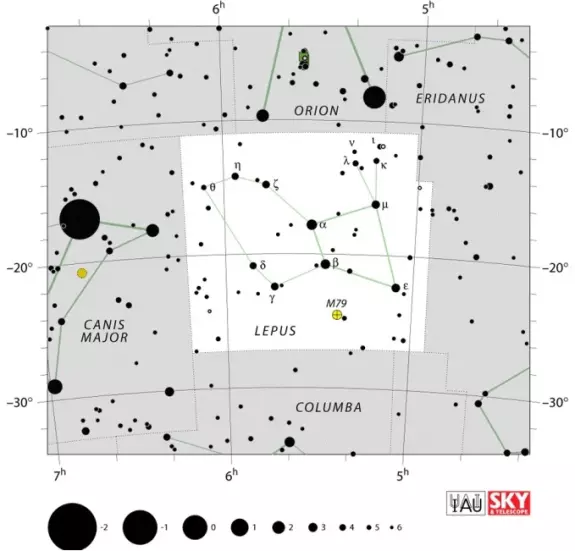
Lepus constellation map by IAU and Sky&Telescope magazine
Lepus myth
Lepus is usually depicted as a hare being hunted by Orion or by his hunting dogs. The constellation is located under Orion’s feet. It is not associated with any particular myth. Sometimes it is also represented as a rabbit, also chased by Orion and his dogs.
Alpha Leporis, the brightest star in the constellation, has the name Arneb, which means “the hare” in Arabic. The hare’s ears are delineated by the stars Kappa, Iota, Lambda and Nu Leporis.
Lepus stars
Arneb – α Leporis (Alpha Leporis)
Alpha Leporis, the brightest star in Lepus, is a lower luminosity yellow-white supergiant star with an apparent magnitude of 2.589. It is approximately 2,200 light years distant from the solar system. It has the stellar classification F0 Ib.
The star’s proper name, Arneb, comes from the Arabic arnab, which means “the hare.”
Arneb has a mass about 14 times that of the Sun, 129 times the solar radius, and it is 32,000 times more luminous. It is believed to be about 13 million years old.
Alpha Leporis is a very old star in the final stages of its life. It is either still expanding or has passed through the supergiant stage and is in the process of contracting and heating up. The star is expected to meet its end as a supernova.
Nihal – β Leporis (Beta Leporis)
Beta Leporis has the stellar classification G5 II. It is a yellow bright giant with an apparent magnitude of 2.84, approximately 160 light years distant from the Sun. Its traditional name, Nihal, means “quenching their thirst.”
The star has 3.5 solar masses and 16 times the solar radius. It is believed to be about 240 million years old.
Beta Leporis is a double star system and possibly a binary star. It is composed of two stars separated by 2.58 arcseconds. The companion star is a suspected variable.
ε Leporis (Epsilon Leporis)
Epsilon Leporis is an orange giant star with the stellar classification K4 III. It has an apparent magnitude of 3.166 and is approximately 213 light years distant.
The star has 40 times the Sun’s radius and 1.70 times the mass. It is believed to be about 1.72 billion years old. It is 372 times more luminous than the Sun.
μ Leporis (Mu Leporis)
Mu Leporis is a blue-white subgiant star with the stellar classification of B9 IV:HgMn. It has an apparent magnitude of 3.259 and is approximately 186 light years distant from the solar system.
The star has 3.4 times the Sun’s radius. It a suspected variable star of the Alpha-2 Canum Venaticorum type, with a period of about two days. The star’s spectrum has overabundances of manganese and mercury.
An X-ray source has been detected at an angular separation of 0.93 arcseconds from the star. This might be a star that is not yet on the main sequence, or a small low-temperature star.
ζ Leporis (Zeta Leporis)
Zeta Leporis has the stellar classification of A2 IV-V(n). The (n) indicates that the absorption lines in the star’s spectrum look nebulous because the star is a rapid spinner, which causes the absorption lines to broaden as a result of the Doppler shift. The star has a rotational velocity of 245 km/s.
Zeta Leporis is a white main sequence star which is evolving into a subgiant. The star has an apparent magnitude of 3.524 and is approximately 70.5 light years distant from the solar system. A massive asteroid belt was confirmed in the star’s orbit in 2001. This was the first extra-solar asteroid belt ever discovered.
The star has 1.46 times the Sun’s mass and 1.5 times the solar radius. It is 14 times more luminous than the Sun. It is believed to be about 231 million years old.
γ Leporis (Gamma Leporis)
Gamma Leporis is a yellow-white main sequence star belonging to the stellar class F6V. It has an apparent magnitude of 3.59 and is 29.3 light years distant. It is a member of the Ursa Major Moving Group.
Gamma Leporis is slightly larger than the Sun, with 1.2 times the Sun’s radius and 1.3 times the solar mass. It is a high-priority target for the Terrestrial Planet Finder mission.
17 Leporis (SS Leporis)
17 Leporis is a spectroscopic binary with a combined visual magnitude that varies between 4.82 and 5.06. The components are of the spectral types A1 and M3-4.5 and have a period of 260.34 days.
17 Leporis is approximately 1,100 light years distant from the solar system.
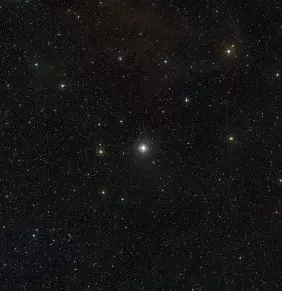
This wide-field image of the sky around the unusual double star SS Leporis is a colour composite made from exposures from the Digitized Sky Survey 2 (DSS2). The field of view is approximately 2.7 degrees. SS Leporis is the bright star at the centre. The coloured rings and the four spikes around the star are artifacts of the photographic process and the optics of the telescope used. They are not real. Image: ESO, Digitized Sky Survey 2. Acknowledgment: Davide De Martin.
η Leporis (Eta Leporis)
Eta Leporis has the stellar classification of F2V. It is a yellow-white dwarf with an apparent magnitude of 3.719, about 49.1 light years distant from the Sun. Excess infrared emission has been detected coming from the star, indicating that it has a dust disk.
Eta Leporis has 1.5 times the Sun’s radius and 1.42 times the mass.
δ Leporis (Delta Leporis)
Delta Leporis is an orange subgiant star with the stellar classification K1IVFe-0.5. It has an apparent magnitude of 3.81 and is approximately 114 light years distant from the solar system.
RX Leporis
RX Leporis is a semi-regular pulsating star with the stellar classification M6.2III. It is a red giant with an apparent magnitude that varies between 5 and 7.4.
The star is approximately 490 light years distant from Earth. It can be found next to Iota Leporis, four degrees south of the bright star Rigel in Orion constellation.
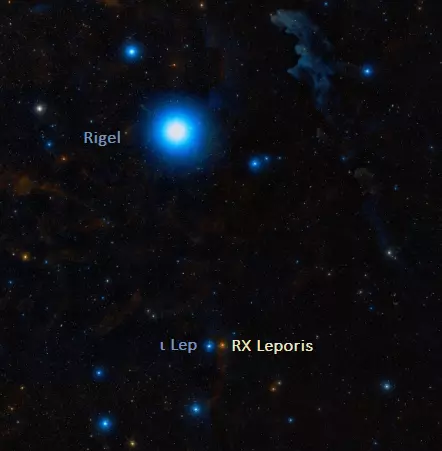
RX Leporis and Rigel, image: Wikisky
Hind’s Crimson Star – R Leporis
R Leporis is a carbon star with the stellar classification of C7,6e(N6e). It is a well-known variable, showing variations in magnitude that range from 5.5 to 11.7.
It is classified as a long-period Mira variable. It has a period of 418-441 days, and a secondary period of about 40 years.
The star was discovered by the British astronomer J. R. Hind in 1845, and named Hind’s Crimson Star in his honour. Hind described the star as appearing “like a drop of blood on a black field.”
R Leporis is a distinctly red star located near the border with Eridanus constellation. It appears reddest when it is dimmest, and during these periods, which occur every 14.5 months, it may be the most visible reddest star in the sky. The intense redness may be the result of the carbon in the star’s outer atmosphere removing the blue part of its visible light spectrum.
Hind’s Crimson Star is approximately 1,300 light years distant. It has a radius about 500 times that of the Sun, and is between 5,200 and 7,000 times more luminous.
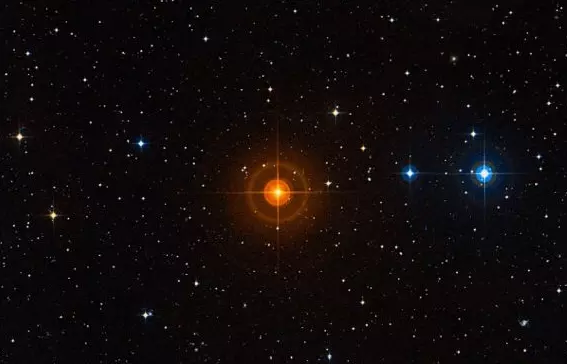
Hind’s Crimson Star, image: Wikisky
Gliese 229
Gliese 229 is a red dwarf belonging to the spectral class M1Ve, only 18.8 light years distant from the Sun. The star has 69 percent of the Sun’s radius and 58 percent of its mass. It is a slow rotator, with a projected rotational velocity of 1 km/s at the equator.
Gliese 229 is a low activity flare star, with magnetic activity on its surface causing random increases in brightness. The star’s corona is a source of X-ray emission.
A substellar companion, a brown dwarf of the spectral type T7, was discovered orbiting the star in 1994 and confirmed in 1995. It was the first confirmed substellar-mass object, with a mass of 20 to 50 times that of Jupiter.
T Leporis
T Leporis is another Mira variable in Lepus constellation. It is a red giant star of the spectral type M6II. It has an apparent magnitude of 9.94 and it pulsates with a period of 380 days. With each pulsation, it loses approximately the mass of Earth. The star is about 500 light years distant and has a mass 100 times that of the Sun.
Asterism
Lepus contains an asterism known as the Throne of Jawza. Sometimes, it is also called the Camels, from the Arabic phrase meaning “camels quenching their thirst.” The stars forming the quadrilateral asterism are α, β, γ and δ Leporis.
Deep sky objects in Lepus
Messier 79 (M79, NGC 1904)
Messier 79 is a globular cluster in Lepus. It has an apparent magnitude of 8.56 and is approximately 41,000 light years distant from Earth.
The cluster was discovered by the French astronomer Pierre Méchain in 1780 and subsequently included in Charles’ Messier’s catalogue.
Like Messier 54 in Sagittarius constellation, the other extragalactic globular cluster in Messier’s catalogue, M79 is believed to have originated outside the Milky Way, in the Canis Major Dwarf Galaxy. The Canis Major Dwarf, located in Canis Major constellation, is currently interacting with the Milky Way and is unlikely to remain intact after the encounter.
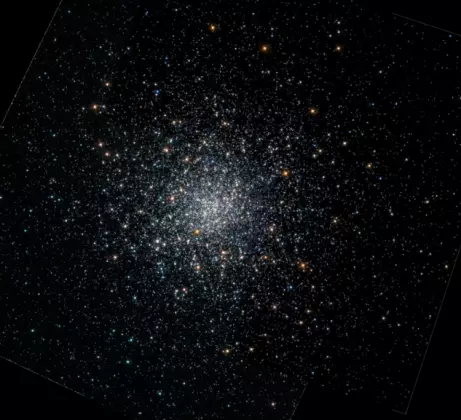
Messier 79, image based on observations made with the NASA, ESA Hubble Space Telescope, and obtained from the Hubble Legacy Archive, which is a collaboration between the Space Telescope Science Institute (STScI, NASA), the Space Telescope European Coordinating Facility (ST-ECF, ESA) and the Canadian Astronomy Data Centre (CADC, NRC, CSA).
Spirograph Nebula – IC 418
IC 418 is a planetary nebula in Lepus. It was named the Spirograph Nebula because it has an intricate pattern, similar to those that can be created with a spirograph.
The nebula has an apparent magnitude of 9.6 and is approximately 3,600 light years distant from the solar system.
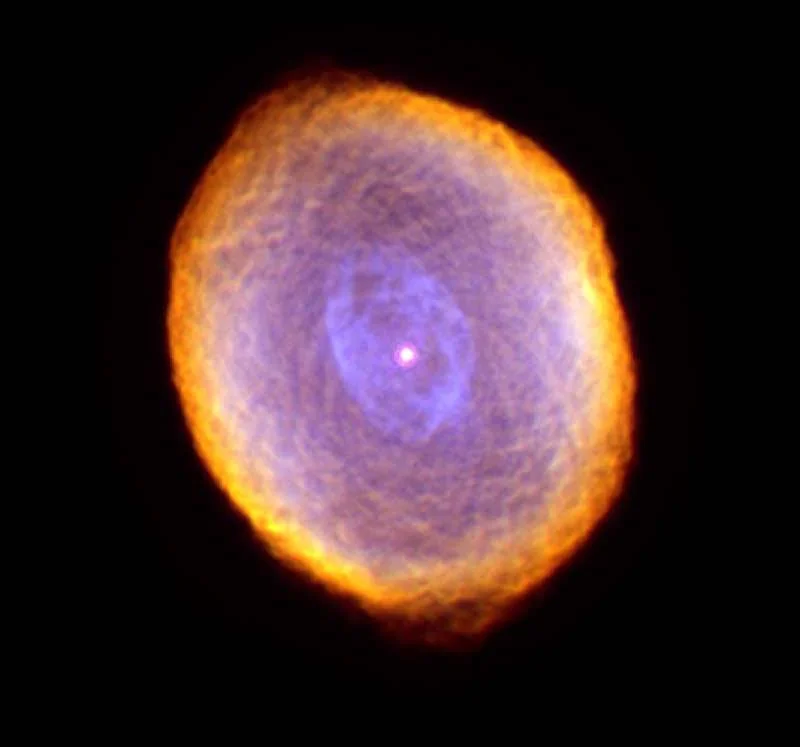
The Spirograph Nebula (IC 418), photographed by the Hubble Space Telescope’s Wide Field Planetary Camera 2. Image: NASA and The Hubble Heritage Team (STScI/AURA)
NGC 1821
NGC 1821 is type IB(s)m irregular galaxy in Lepus. It has an apparent magnitude of 14.5. The galaxy was discovered by the American astronomer Frank Leavenworth in 1886.
A supernova, SN 2002bj, was observed in the galaxy in 2002. At first it had an apparent magnitude of 14.7 and was classified as a Type IIn supernova, but in 2008, it was determined that the spectrum resembled that of a Type Ia supernova more closely.
The progenitor star system is believed to have been composed of two white dwarfs, with helium being transferred from one to the other. Once the helium accreted, it ignited a thermonuclear reaction on the surface of the more massive star, which resulted in the outburst.